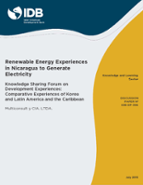Renewable Energy Experiences in Nicaragua to Generate Electricity
Date
Jul 2015
In 2013, Nicaragua ranked third in Latin America for investments in renewable energy. This was because Nicaragua's energy composition had a high level of renewable sources and investments in renewable energy were high relative to the size of its economy. In 2008, electricity generated in Nicaragua from fuel oil was 68 percent while renewable energy was responsible for only 32 percent. By 2014, however, the electricity generated using renewable resources increased to 52 percent.Multiple institutions share responsibility for governing Nicaragua's electricity sector. The main institution is the Ministry of Energy and Mines (MEM), which is in charge of producing policies and strategies to develop the national electricity sector and granting the authorizations to generate, transmit and distribute electricity. This Ministry plays an important role in developing renewable energy in Nicaragua and its main goal is to maintain an energy policy that allows continued electricity generation from renewable resources.
Nicaragua is determined to transform its energy composition from one heavily reliant on fuel oil to one based principally on renewable energy. For that reason, the Nicaraguan government has approved specific laws that provide incentives to boost electricity generation through the development of renewable energy projects.
The electrification rate has increased steadily in Nicaragua, from 47 percent in 2002 to 80 percent in 2014. Part of this increase is due to small hydroelectric power plants in rural areas.
The development of renewable energy in Nicaragua has led to a number of positive outcomes that include the improved governance and regulation of the energy sector, stabilization of energy policy, creation of an investment promotion agency with private-sector participation, and increased international cooperation.
In the last 3 years, increased electricity generation through renewable energy has stabilized energy prices for consumers. Nicaragua's goal is to generate 90 percent of its electricity from renewable resources by 2020.
Nicaragua is determined to transform its energy composition from one heavily reliant on fuel oil to one based principally on renewable energy. For that reason, the Nicaraguan government has approved specific laws that provide incentives to boost electricity generation through the development of renewable energy projects.
The electrification rate has increased steadily in Nicaragua, from 47 percent in 2002 to 80 percent in 2014. Part of this increase is due to small hydroelectric power plants in rural areas.
The development of renewable energy in Nicaragua has led to a number of positive outcomes that include the improved governance and regulation of the energy sector, stabilization of energy policy, creation of an investment promotion agency with private-sector participation, and increased international cooperation.
In the last 3 years, increased electricity generation through renewable energy has stabilized energy prices for consumers. Nicaragua's goal is to generate 90 percent of its electricity from renewable resources by 2020.



